The National Children's Home Story
Emigration
In order to keep places available for new arrivals, there was always a pressure on institutions such as the Children's Home to find new homes for existing inmates. Emigration to countries such as Canada played an important part in dealing with this problem, as well as being seen as giving children the opportunity of a better future than they might find in Britain. Canada had a special attraction for the Home's Principal, Thomas Stephenson, who viewed it as a particularly moral and egalitarian country.
In June 1872, Stephenson visited the USA and Canada where he met Dr Morley Punshon, a preacher and supporter of Stephenson's work, who accompanied him on the tour. Stephenson's mission was to determine whether it would be desirable to send the Home's children to Canada, and what the practicalities would be in placing them with new families or employers. Some of those he met during his visit were already involved in child emigration such as the Ellen Bilborough and Emma Barber who ran the homes at Belleville and Knowlton established by the independent emigration organiser, Annie Macpherson. At Hamilton, Ontario, he also met Senator W.E. Sanford who subsequently became Treasurer of the Canadian branch. Support at Hamilton also materialised in the raising of £1,000 to buy a house and land to establish a distributing home.
The clearest message that Stephenson picked up on his visit was that Canada would embrace youngsters who were equipped with manual skills for their new life, whereas untrained children would not be welcome. If this condition were met, he had been assured, then the only difficulty would be in supplying all the applicants who would ask for his children.
The scheme was given approval by the Methodist Conference and a property was acquired at 1078 Main Street, Hamilton. The first governor was a respected citizen of Winnipeg, Mr R.T. Riley.
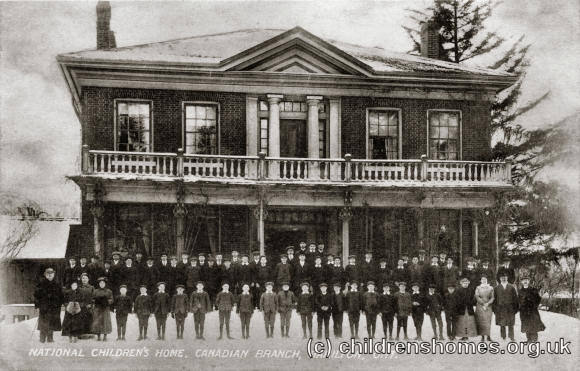
Children and staff at 1078 Main Street, Ontario, c.1900. © Peter Higginbotham
In May 1873, the first party of thirty-four boys and fifteen girls sailed for Canada in the charge of Francis Horner, one of the Children's Home's co-founders. By September, Horner was able to report that two hundred applications for the children had been received, and they had finally been placed with forty-five families of which thirty-seven belonged to the Wesleyan Methodist Church. Twenty-six of the boys had joined farming families, two were learning carpentry, two the blacksmith's and wheelwright's trades, two were employed in Senator Sanford's warehouse, and two 'printer boys' in the Methodist Book-room in Toronto. Five of the girls had been adopted into Christian families, six had been taken on as domestic servants, and four had gone into farming families.
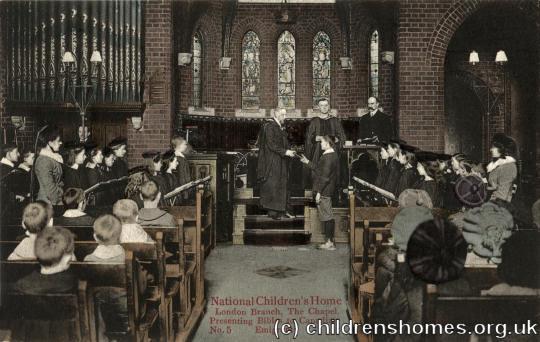
Bible presentation to children emigrating to Canada, c.1905. © Peter Higginbotham
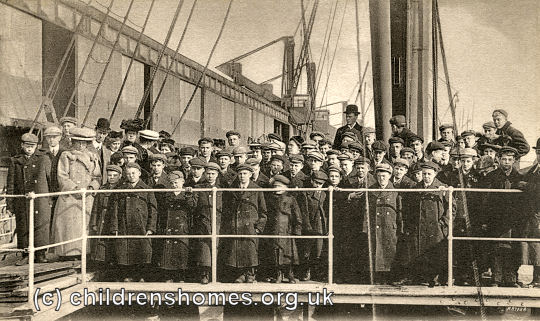
An NCH emigration party setting sail for Canada, c.1905. © Peter Higginbotham
In 1874, Stephenson himself accompanied a party of ten boys and thirty girls to Canada. His report of the visit detailed the arrangements that had been put in place for the care and monitoring of the children:
The Children's Home at Hamilton is a pleasant place. There are about eight acres of good land, which produces grapes, peaches, and strawberries in profusion, as well as the plainer and more substantial vegetables. There is a well-built brick house, and a large wooden house behind, containing dormitory, dining-room, and lavatory, intended for the reception of the young emigrants on their first arrival. The cost of all has been about 11,000 dollars, the whole of which has been, or will be, contributed by Canadians. Hamilton is the heart of the very garden of Canada. Moreover, it is a great and growing railway centre, and, therefore, an admirable place for a distributing "Home." The use of such a Canadian centre is threefold. It is a reception house for the children on their arrival in the country. It is also a house of shelter for any of them who, through sickness or other causes, are thrown out of the situations to which they are sent; and it is a residence and office for the governor or agent, who keeps up a frequent correspondence with the children, and visits them at regular intervals. In any good system of juvenile emigration there should certainly be supervision of the children, and a more or less authoritative guardianship over them for at least three years after their arrival in their adopted land.
I want now to explain by what process the children are distributed. When the time draws near at which a party of children is expected, a notice to that effect is inserted in one or two newspapers; and forthwith each mail brings in applications. To every applicant is sent a printed paper of questions; from the answers to which a judgement may be formed as to his status and character, and as to the sort of boy or girl he desires to have. This application must be accompanied by a certificate of character from a magistrate or clergyman, and preference is given to those who are members of some Christian communion. Frequently other means are available for estimating the character of the applicant; and there is rarely much difficulty in coming to a tolerably correct judgement. To the applicants the children are then allotted, after a careful consideration of each child's character and probable fitness for the situation. They are accepted for these purposes:
1. Bona fide adoption. This is in the case of little children, not more than five or six years old.
2. "Raising," which is something less than adoption, but much more than service. Children of eight or nine are received by respectable people into their houses to be treated as members of the family, to receive regular schooling, and to be clothed. In return for this they will do "little chores," little bits of work around the house, such as carrying in a few sticks of firewood, or running to the post-office with a letter, or feeding the fowls, or perhaps opening the gate of the meadow for the cows to come up to be milked. A very warm affection often grows up between such children and their patrons; and in many of these cases the children do not leave the family to which they are sent until they are ready to settle in life.
3. Service, in which for work to be done on the farm, in a shop, or in the house, a fixed scale of payment is agreed on, varying from three to six dollars per month, in addition to board and lodging. In all cases, the agreement reserves to the representative of the Home the right to withdraw the child if he is improperly treated. There are more applications for girls than boys; but for both the demand is greatly in excess of the supply.
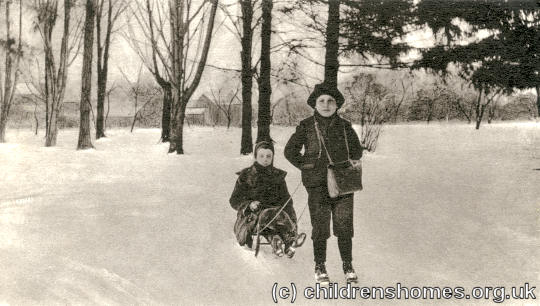
Children from NCH Ontario Home off to school, c.1900. © Peter Higginbotham
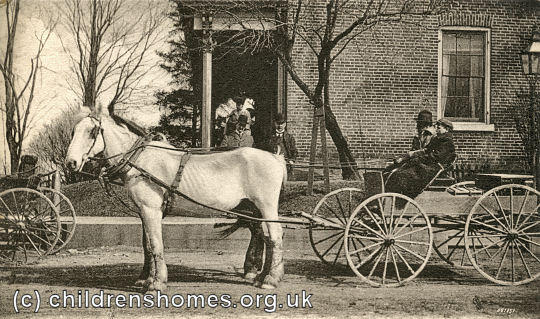
A boy from the home setting off for his first employment, c.1905. © Peter Higginbotham
Despite occasional criticism of the treatment or monitoring that some children received in Canada, emigration soon became the fate of most of those leaving the Children's Home. By 1909, of the 3,709 of the children who had ever left the care of the Home, 2,157 (58 per cent) had gone to Canada, with 50 more to Australia and New Zealand.
Images of children who had done well in Canada were often published by the NCH as an endorsement of their emigration scheme.
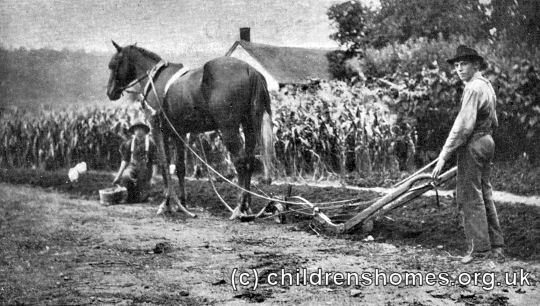
A former NCH boy at work in Canada, c.1905. © Peter Higginbotham
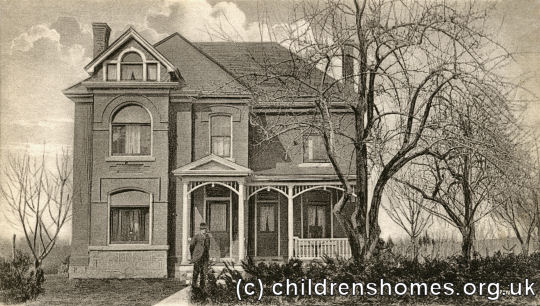
A former NCH boy with his own house in Canada, c.1905. © Peter Higginbotham
Emigration was halted during the First World War and, with increasing restrictions being imposed by the Canadian government, numbers declined sharply. From 1924, a complete bar was imposed emigrants who were below working age. As a result, the Hamilton home finally closed in 1934.
With the ending of emigration to Canada, a new destination emerged in the shape of Australia. In the years up to the Second World War, a few groups of children had been sent to Australian institutions such as the Fairbridge Farm School. After the war, the Australian government launched a drive to promote immigration, including that of children, with financial support provided for their settlement. In 1947, it announced a target of 50,000 children, which were mainly being sought from Britain and Europe. Encouragement to make use of the scheme was given to NCH by the Northcote Farm School in Victoria, to which the NCH had sent thirty-three boys and four girls before the war.
The Home's Principal, John Litten, visited Australia in 1948 and was impressed by what he was told — the Australian government would not only pay the travel costs of children emigrating, but also give a grant towards the equipping any establishments set up by the Home. In addition, the existing Methodist Children's Home in Melbourne had offered to take up to fifty children aged from 4 to 10 years. Litten's proposal to canvass all the parents and guardians of the children in the care of the Home as to their interest in the scheme received a lukewarm reception, however. Some members of the charity's executive body and the then Principal Designate, John Waterhouse, felt that more caution was needed before the Home committed itslef too deeply. As a result, the numbers of the Home's children migrating to Australia were small, fifty-three boys and twenty-nine girls in the first year, but a total of only ninety-one over the whole of the period 1950-54. The children that did go underwent a month-long preparation at the Alverstoke home. They were settled at four locations: Dalmar, Carlingford, Sydney; Magill, Adelaide; Cheltenham, Melbourne; and Victoria Park, Perth. A Sister was sent to accompany each group.
Some aspects of the scheme received criticism from the parents of children sent to Australia. Despite assurances that children unhappy in their new surroundings could be sent back, it transpired that this would only happen on a payment of £65 (a relatively large amount at that date) being made to cover the cost of the return passage. It also emerged that some children had been separated from the brothers and sisters they had previously lived with in children's homes back in Britain.
Except where indicated, this page () © Peter Higginbotham. Contents may not be reproduced without permission.


